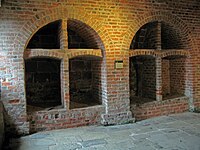


A buttery was originally a large cellar room under a monastery, in which food and drink were stored for the provisioning of strangers and passing guests. Nathan Bailey's An Universal Etymological English Dictionary gives "CELLARIST – one who keeps a Cella, or Buttery; the Butler in a religious House or Monastery." As the definition in John Stevens's The History of the Antient Abbeys shows, its initial function was to feed and water the guests rather than monks: "The Buttery; the Lodging for Guests". In a monastery a buttery was thus the place from which travellers would seek 'doles' of bread and weak ale, given at the exterior buttery door (and often via a small serving-hatch in the door, to prevent invasion of the stores by a crowd or by rough beggars). The task of doling out this free food and drink would be the role of the butterer. At larger monasteries there would also be a basic hostelry, where travellers could sleep for free.
Later the term buttery was also applied to a similar stores-room in a large medieval house, which might or might not be a cellar, and in which the buttery served the lord and his household rather than only passing travellers.
In both its uses, a buttery is to be distinguished from the butter and lard-house (pantry or larder), and the kitchen, a hostelry, or the refectory for guests or the dining hall for the inhabitants.